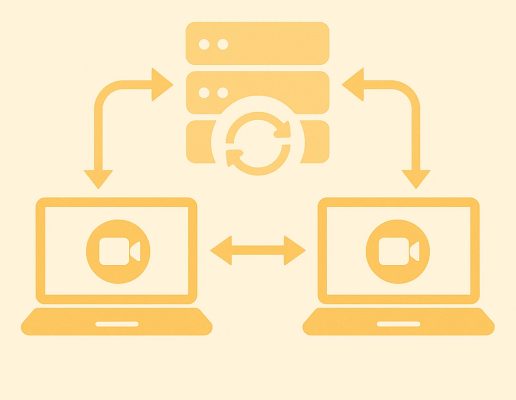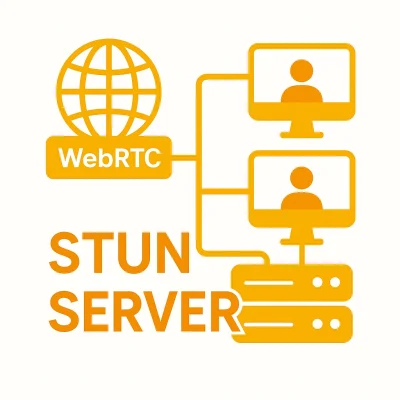From monitoring smart home cameras to enabling remote maintenance of industrial equipment, real-time video and data streaming are at the core of many modern digital experiences. Whether you’re troubleshooting a connected thermostat, analyzing live surveillance footage, or enabling video chat on a customer support app, chances are you’re relying on WebRTC – the protocol that powers low-latency, peer-to-peer communication between devices.
But while both Amazon Kinesis and Nabto rely on WebRTC for real-time communication, the way this technology is implemented – and the problems it’s meant to solve – can vary dramatically. Amazon Kinesis, a cloud-based service from Amazon Web Services (AWS), is designed for organizations that need to ingest, store, and analyze massive volumes of streaming data – such as video feeds from security systems, patient monitoring in hospitals, or customer behavior tracking in retail environments. In contrast, Nabto uses WebRTC to enable secure, direct communication with individual IoT devices, making it ideal for applications like remotely unlocking a smart door, adjusting a connected thermostat, or checking a live feed from a home surveillance camera – without routing any data through the cloud.
This article compares how Amazon Kinesis and Nabto use WebRTC to serve very different goals: large-scale data processing versus decentralized, real-time device control.
CTA Video Demo
Understanding WebRTC and Amazon Kinesis
WebRTC is an open-source protocol that enables real-time audio, video, and data sharing directly between web browsers or mobile apps. It’s what makes video calls, live chats, and collaborative tools feel instantaneous. But while WebRTC excels at low-latency, peer-to-peer communication, it wasn’t built to handle large-scale storage, analysis, or long-term processing of media streams.
That’s where Amazon Kinesis Video Streams steps in. As part of AWS’s cloud infrastructure, Kinesis lets businesses go beyond basic real-time exchange by capturing, storing, and analyzing live video feeds from IoT devices, surveillance cameras, and other sources. When paired with WebRTC, Kinesis allows organizations not only to stream video in real-time but also to retain those streams for future review, integrate them with machine learning tools, or analyze patterns across multiple data sources.
This combined approach opens the door to advanced use cases—from patient video monitoring in hospitals, to multi-location security systems, to customer behavior analytics in retail environments.
Advantages of Amazon Kinesis with WebRTC
While WebRTC is excellent for real-time, peer-to-peer video communication, deploying it at scale – especially across many users or devices – comes with infrastructure challenges. For instance, devices need a way to find each other and establish a connection (known as signaling), and many networks use firewalls or routers that block direct communication (NAT traversal). To overcome these barriers, developers often need to set up additional components like signaling servers and media relays, which can be complex and time-consuming to manage.
Amazon Kinesis Video Streams with WebRTC simplifies all of this by offering a fully managed service. AWS takes care of the signaling, provides TURN and STUN servers to handle NAT traversal, and supplies media relay services when direct connections aren’t possible. That means developers can focus on building their real-time video applications – like customer support tools, remote health monitoring systems, or security dashboards – without worrying about the technical plumbing behind the scenes.
Beyond just making WebRTC easier to deploy, AWS also offers tools to enhance and extend video capabilities. With Kinesis and its broader ecosystem, businesses can:
- Store video streams in Amazon S3 for long-term playback or auditing
- Analyze video content using AWS’s AI and machine learning tools (e.g., for motion detection or facial recognition)
- Secure video access with AWS Identity and Access Management (IAM) controls
- Respond to video data in real-time using Amazon Kinesis Data Streams and AWS Lambda functions
By using Kinesis Video Streams with WebRTC, organizations get the best of both worlds: real-time communication combined with powerful cloud storage, analytics, and security tools.
Understanding Nabto with WebRTC
While Amazon Kinesis is built to support large-scale, cloud-based video processing and long-term data analysis, Nabto takes a very different approach. It uses WebRTC to enable direct, peer-to-peer communication between IoT devices and client applications – without routing any data through a cloud server.
This model is especially well-suited to IoT environments in which immediate control, privacy, and simplicity matter more than large-scale storage or analytics. For example, with Nabto, a user can unlock a smart door, adjust a thermostat, or view a live security camera feed in real time, without sending that data to the cloud or relying on a third-party platform to relay the information.
Nabto’s architecture is ideal for:
- Smart homes – Remotely controlling locks, lights, or thermostats with a direct device-to-user connection
- Industrial IoT – Monitoring and managing on-site equipment in real time, even in environments with strict data privacy requirements
- Remote field service – Offering support and diagnostics for devices deployed in the field, without requiring cloud-based access layers
By eliminating the need for intermediary cloud services, Nabto reduces infrastructure complexity, strengthens security, and ensures that data stays within the local network or between trusted endpoints. This makes it an appealing option for businesses that prioritize real-time responsiveness and data privacy over centralized processing and analysis.

The Nabto Difference
Amazon Kinesis is built for scale – streaming, storing, and analyzing video and data in the cloud across thousands of sources. Nabto, by contrast, is designed for simplicity and security at the device level. Instead of sending data to a central cloud platform, Nabto enables direct, peer-to-peer communication between IoT devices and end users.
This decentralized architecture offers several advantages for businesses managing connected devices:
- Lower risk of data exposure – Since information doesn’t pass through a third-party cloud server, there’s less surface area for breaches.
- Reduced complexity – No need to maintain cloud infrastructure or manage backend analytics pipelines.
- Real-time responsiveness – Direct communication means faster interactions without the delay of routing through the cloud.
For IoT companies, this means more control and greater flexibility. Nabto’s WebRTC-based approach is especially valuable in use cases where privacy is critical, infrastructure needs to remain lightweight, or latency must be minimized – such as in home automation, remote equipment control, or offline-capable environments.
Amazon Kinesis vs. Nabto WebRTC security and privacy
One of the key reasons businesses choose Nabto over cloud-based platforms like Amazon Kinesis is its emphasis on privacy and control. For applications in which IoT devices operate in remote, personal, or high-stakes environments – such as home security systems, industrial equipment, or healthcare monitors – the ability to maintain secure, real-time communication without involving cloud servers is more than a convenience; it’s a necessity.
Because Nabto uses peer-to-peer WebRTC connections, data stays between the device and the user, never passing through third-party servers. This means sensitive information – whether it’s a video feed from a baby monitor or performance data from a factory machine – remains within a trusted environment. The result is reduced exposure to external threats, fewer regulatory hurdles, and stronger guarantees of confidentiality.
This architecture also simplifies compliance for industries like healthcare and finance, where strict data privacy standards apply. And since there’s no need to pay for cloud storage or ongoing infrastructure management, Nabto can significantly lower operational costs while increasing security.
In contrast, Amazon Kinesis offers robust tools for managing and analyzing video data at scale – but because that data is stored and processed in the cloud, businesses must implement additional safeguards, such as encryption, access controls, and regular audits, to mitigate risk. For organizations with strict privacy requirements or limited budgets for cloud infrastructure, this added complexity can be a barrier.
By eliminating the need for centralized processing and keeping communication local, Nabto delivers both stronger security and greater cost-efficiency – two priorities that are increasingly top-of-mind for businesses managing distributed IoT systems.
Will You Ever Need to Choose Between the Two?
While Nabto and Amazon Kinesis are built for different architectural approaches, there are situations in which a developer or business might consider both. For example, if you’re building an IoT application with video capabilities, you may be deciding between a cloud-based system that stores and analyzes video data (Kinesis) and a lightweight, peer-to-peer setup that prioritizes direct device control and privacy (Nabto).
The right choice depends on your priorities: choose Kinesis if you need centralized storage, analytics, and integration with other AWS services; choose Nabto if you need real-time responsiveness, reduced complexity, and full control over your data flow. Understanding the trade-offs helps ensure you’re building a system that aligns with your performance, cost, and privacy goals.
Final Thoughts
For businesses building IoT systems with real-time video or data streaming, choosing the right architecture matters. Amazon Kinesis offers robust tools for managing large-scale, cloud-based video analytics, but that power comes with complexity, cost, and cloud dependency. Nabto, by contrast, provides a lightweight, peer-to-peer alternative that prioritizes privacy, responsiveness, and control.
If your priority is secure, direct communication between devices – without the need for cloud infrastructure – Nabto offers a compelling option. It’s especially well-suited for applications in smart homes, industrial IoT, and remote service, where simplicity and data ownership are key. In an environment in which real-time control and privacy are increasingly valued, Nabto gives businesses a streamlined, cloud-free path forward.
Read our other resources
We’ve published a range of resources for our community, including:
- What is WebRTC in video streaming?
- Learn more about P2P from the developer perspective
- What are the top WebRTC use cases in IoT?








